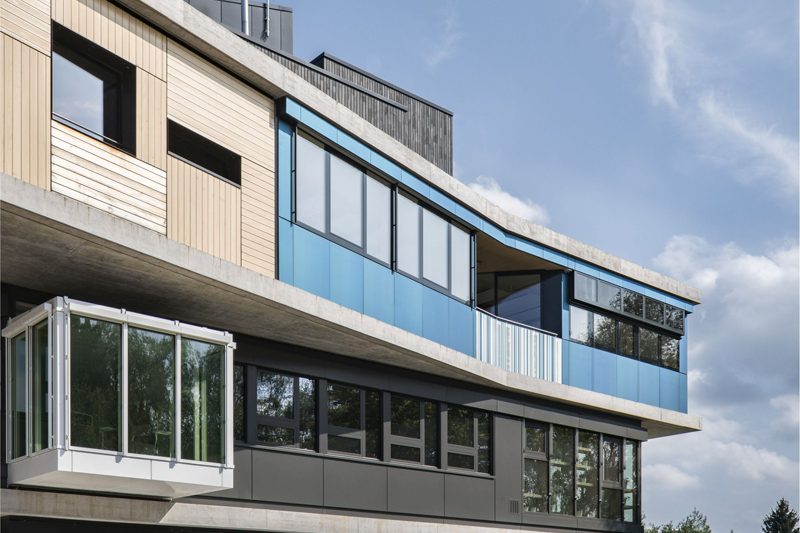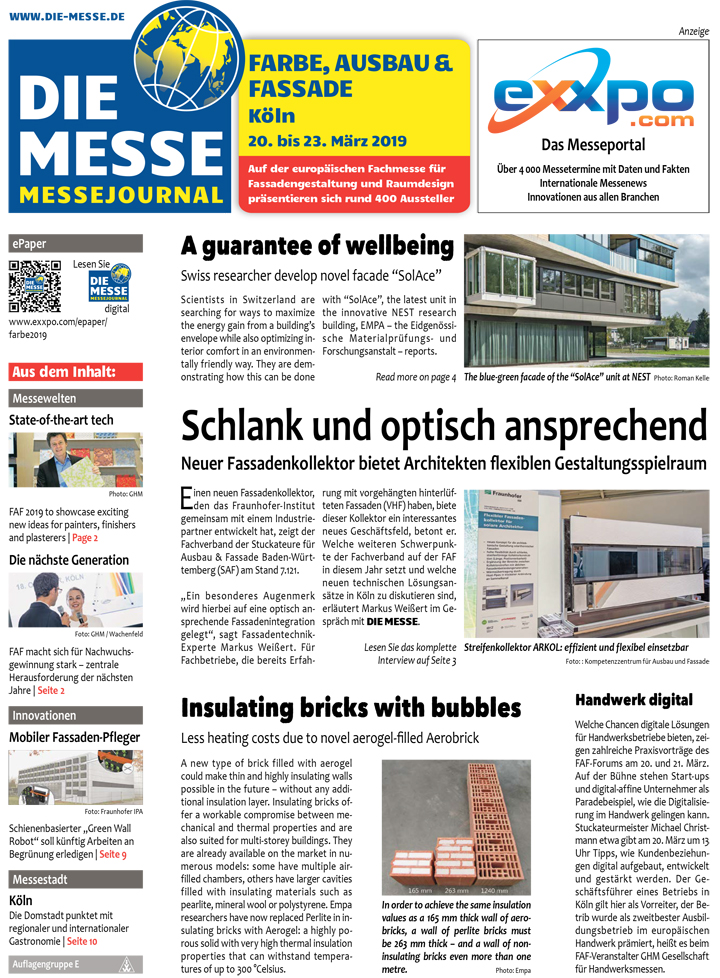20 March 2019
The blue-green facade of the “SolAce” unit at NEST shimmers like a butterfly’s wing in the sunlight. The latest addition to Empa and Eawag’s research and innovation building in Dübendorf combines workspace and living space over almost 100 square meters and is integrated in NEST’s south-facing side between the second and third platform of the typecase-like structure.
“Through its facade, ‘SolAce’ is to produce more energy than the unit needs over the course of the year, while at the same time providing the best possible comfort to the users”. That’s how Jean-Louis Scartezzini explains the objective of the project. The EPFL researcher is the Director of the Solar Energy and Building Physics Laboratory, and the idea for the latest NEST unit is his brainchild. To achieve this goal, the researchers combine several active and passive facade elements that feature technologies developed at the Lausanne-based lab. Some of those technologies are about to be commercialized by start-ups and collaborations with partners from industry, while others still have a way to go. “NEST gives us the unique opportunity to examine the various technologies in interaction with each other and in a real-life environment”, says Scartezzini.
The unit’s positive energy balance is to be achieved by producing solar electricity and hot water directly on the facade. Photovoltaic modules and solar thermal collectors with a novel type of colored nano-glazing will be used for this purpose. With the aim of promoting the integration of photovoltaic units in the building envelope by offering greater architectural scope through different colors, a team at EPFL has been researching coatings for coloration for almost 20 years. The research team, led by Andreas Schüler, was clear on the fact that the coating would need to cause as little energy loss as possible. There was no question of using absorbing color pigments. Instead, thin films of between 5 and 200 nanometers create what are referred to as “interference color effects” on the interior of the glazing, not unlike those that appear on a soap bubble or on the wings of a butterfly for example. “Because the nano-coating is very transparent, there are virtually no absorption effects and just very minor energy losses”, explains Schüler. This technology has now been patented and is currently being brought to market by a spin-off.
Besides office space for four people, “SolAce” also offers a living area for two. To keep the promise of optimum comfort, the researchers are attempting to recreate the users’ individual perception by using innovative optical sensors. The prototype sensors measure lighting conditions and glare from a user’s perspective, for instance a person working at a computer. This on-the-fly monitoring is used to control electric lighting and sun shading in the best possible way.
https://www.empa.ch/
Swiss researcher develop novel facade „SolAce“
Scientists in Switzerland are searching for ways to maximize the energy gain from a building’s envelope while also optimizing interior comfort in an environmentally friendly way. They are demonstrating how this can be done with “SolAce”, the latest unit in the innovative NEST research building, EMPA – the Eidgenössische Materialprüfungs- und Forschungsanstalt – reports.
 Photo: Roman Keller Photo: Roman KellerThe unit’s positive energy balance is to be achieved by producing solar electricity and hot water directly on the facade. |
“Through its facade, ‘SolAce’ is to produce more energy than the unit needs over the course of the year, while at the same time providing the best possible comfort to the users”. That’s how Jean-Louis Scartezzini explains the objective of the project. The EPFL researcher is the Director of the Solar Energy and Building Physics Laboratory, and the idea for the latest NEST unit is his brainchild. To achieve this goal, the researchers combine several active and passive facade elements that feature technologies developed at the Lausanne-based lab. Some of those technologies are about to be commercialized by start-ups and collaborations with partners from industry, while others still have a way to go. “NEST gives us the unique opportunity to examine the various technologies in interaction with each other and in a real-life environment”, says Scartezzini.
The unit’s positive energy balance is to be achieved by producing solar electricity and hot water directly on the facade. Photovoltaic modules and solar thermal collectors with a novel type of colored nano-glazing will be used for this purpose. With the aim of promoting the integration of photovoltaic units in the building envelope by offering greater architectural scope through different colors, a team at EPFL has been researching coatings for coloration for almost 20 years. The research team, led by Andreas Schüler, was clear on the fact that the coating would need to cause as little energy loss as possible. There was no question of using absorbing color pigments. Instead, thin films of between 5 and 200 nanometers create what are referred to as “interference color effects” on the interior of the glazing, not unlike those that appear on a soap bubble or on the wings of a butterfly for example. “Because the nano-coating is very transparent, there are virtually no absorption effects and just very minor energy losses”, explains Schüler. This technology has now been patented and is currently being brought to market by a spin-off.
Besides office space for four people, “SolAce” also offers a living area for two. To keep the promise of optimum comfort, the researchers are attempting to recreate the users’ individual perception by using innovative optical sensors. The prototype sensors measure lighting conditions and glare from a user’s perspective, for instance a person working at a computer. This on-the-fly monitoring is used to control electric lighting and sun shading in the best possible way.
https://www.empa.ch/
More news about "Farbe, Ausbau & Fassade":
10 March 2016
New impulses through the FAF FARBE, AUSBAU & FASSADE: The "Rendering Codes" special exhibition illustratively presented the future potential of stucco plaster as an artistic facade element. (more…)
| FAIR NAVIGATOR BUILDING | |
|---|---|
|
| E-PAPER FARBE, AUSBAU & FASSADE |
 |
